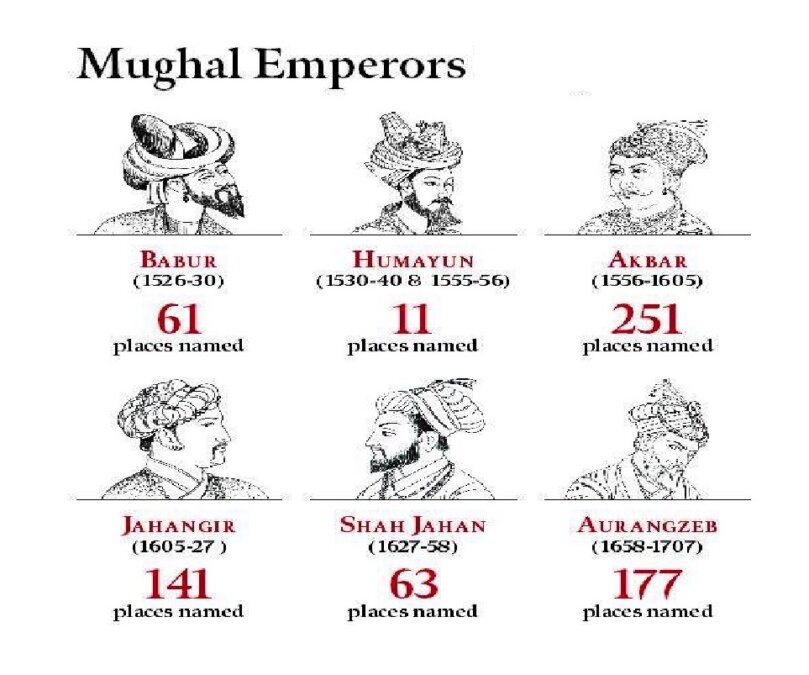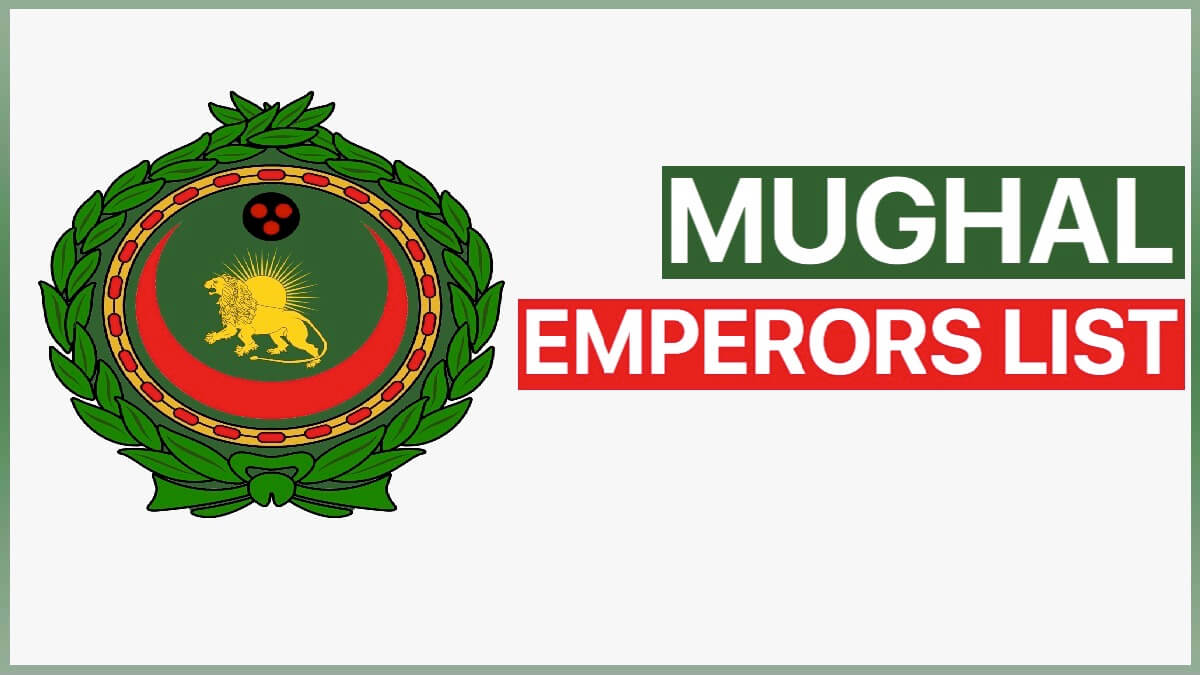Mughal emperor list include Babur, Akbar, Jahangir, Shah Jahan, and Aurangzeb. Each emperor made their unique contributions to the empire's development and legacy, whether it be through political and economic reforms, cultural advancements, or military conquests
The Mughal Empire list, covering the modern-day countries of India, Pakistan, Afghanistan, and Bangladesh, was headed by the Mughal emperor who held supreme authority over the state. The Mughals established their reign in parts of India in 1526 and eventually ruled over most of the subcontinent by 1707. Although their power declined rapidly afterward, they continued to exercise nominal control over territories until the 1850s.
The Mughal emperors were descendants of the Turco-Mongol Timurid dynasty hailing from Central Asia. Their founder, Babur, was a Timurid prince from the Fergana Valley, which is presently part of Uzbekistan. Babur was a direct descendant of Timur (known as Tamerlane in the West) and was also related to Genghis Khan through Timur's marriage to a princess of the Genghisid lineage
The Mughal Emperors ruled India for almost two centuries. The Mughals were Muslims who ruled this Hindu subcontinent. They are an important part of Indian history. They left behind many architectural pieces like Red Fort, Taj Mahal, and more. Bahur was the founder of this empire. Mughal Empire List is given below.
Mughal Empire List
Mughal Empire List:- the Mughal empire was founded by Babur, a Timurid prince and ruler from Central Asia. Babur was a direct descendant of the Timurid Emperor Tamerlane on his father's side, and the Mongol ruler Genghis Khan on his mother's side. Ousted from his ancestral domains in Turkistan by Sheybani Khan, the 40-year-old Prince Babur turned to India to satisfy his ambitions. He established himself in Kabul and then pushed steadily southward into India from Afghanistan through the Khyber Pass. Babur's forces occupied much of northern India after his victory at Panipat in 1526. The preoccupation with wars and military campaigns, however, did not allow the new emperor to consolidate the gains he had made in India.
The instability of the empire became evident under his son, Humayun, who was driven into exile in Persia by rebels. Humayun's exile in Persia established diplomatic ties between the Safavid and Mughal Courts and led to increasing West Asian cultural influence in the Mughal court. The restoration of Mughal rule began after Humayun's triumphant return from Persia in 1555, but he died from an accident shortly afterwards. Humayun's son, Akbar, succeeded to the throne under a regent, Bairam Khan, who helped consolidate the Mughal Empire in India. Mughal Empire List PDF is given below.
List of Mughal Emperors in India
List of Mughal Emperors is given below (1526-1857).
| Emperor | Reign | Description |
|---|---|---|
| Babur | 1526–1530 | Was a direct descendant of Genghis Khan through Timur and was the founder of the Mughal Empire after his victories at the Battle of Panipat (1526) and the Battle of Khanwa |
| Humayun | I- 1530–1540
II – 1555–1556 | Reign interrupted by Suri Dynasty. Being young and inexperienced led him to be regarded as a less effective ruler than Sher Shah Suri, who defeated him and established the Suri Dynasty.
Restored rule was more unified and effective than the initial reign of 1530–1540. He left the unified empire to his son, Akbar. |
| Akbar (was one of the youngest rulers. Became a ruler at the age of 13) | 1556–1605 | He and Bairam Khan defeated Hemu during the Second Battle of Panipat and later won famous victories during the Siege of Chittorgarh and the Siege of Ranthambore. One of his most famous construction marvels was the Lahore Fort. He abolished Jizyah tax imposed on Hindus.
To know more about Akbar’s successors, check the linked article. |
| Jahangir | 1605–1627 | Opened relations with the British East India Company. |
| Shah Jahan | 1628–1658 | Born on 5th January 1592.
Under him, Mughal art and architecture reached their zenith. He constructed the Taj Mahal, Jama Masjid, Red Fort, Jahangir mausoleum, and Shalimar Gardens in Lahore. Died in the captivity of his son Aurangzeb. |
| Aurangzeb | 1658–1707 | He ascended the throne on 31st July 1658.
He reinterpreted Islamic law and presented the Fatawa-e-Alamgiri. He captured the diamond mines of the Sultanate of Golconda and spent the major part of his last 27 years in the war with the Maratha rebels and expanded the empire to its greatest extent. |
| Bahadur Shah I (also known as Muazzam/Shah Alam I) | 1707–1712 | After his reign, the empire went into steady decline due to the lack of leadership qualities among his immediate successors. He released Shahuji, Son of Shambuji, who was the elder son of Shivaji. |
| Jahandar Shah | 1712–1713 | Was an unpopular incompetent titular figurehead. |
| Furrukhsiyar | 1713–1719 | His reign marked the ascendancy of the manipulative Syed Brothers, execution of the rebel Banda. In 1717 he granted a Firman to the English East India Company granting them duty-free trading rights for Bengal. The Firman was repudiated by the notable Murshid Quli Khan. |
| Rafi Ul-Darjat | 1719 | The 10th Mughal Emperor. He succeeded Furrukhsiyar, being proclaimed Badshah by the Syed Brothers. |
| Rafi Ud-Daulat | 1719 | Was Mughal emperor for a brief period in 1719. |
| Muhammad Ibrahim (Claimant to the throne) | 1720 | Brother of Rafi Ul-Darjat
Attempted to seize the throne at the behest of the Syed Brothers in order to depose emperor Muhammad Shah |
| Muhammad Shah (also called Rangeela) | 1719–1720
1720–1748 | Got rid of the Syed Brothers. Countered the emergence of the renegade Marathas and lost large tracts of the Deccan and Malwa in the process. Suffered the invasion of Nadir-Shah of Persia in 1739. |
| Ahmad Shah Bahadur | 1748–1754 | Son of Muhammad Shah. His Minister Safdarjung was responsible for the Mughal Civil War. He was defeated at Sikandarabad by the Maratha Confederacy. |
| Alamgir II | 1754–1759 | He was murdered by a conspiracy of Imad-Ul-Mulk and his Maratha associate Sadashivrao Bhau |
| Shah Jahan III | 1759-1760 | He was overthrown after the Third Battle of Panipat by Prince Mirza Jawan Bakht. |
| Shah Alam II | 1760–1806 | He is known to have fought against the British East India Company during the Battle of Buxar and reformed the Mughal Army under the command of Mirza Najaf Khan, He is thus known as one of the last effective Mughal Emperors. |
| Akbar Shah II | 1806–1837 | He designated Mir Fateh Ali Khan Talpur as the new Nawab of Sindh. Although he was under British protection his imperial name was removed from the official coinage after a brief dispute with the British East India Company. |
| Bahadur Shah II | 1837–1857 | He was the last Mughal Emperor. He was deposed by the British and exiled to Burma following the Indian Rebellion of 1857. |

Mughal Empire List PDF
Download Mughal Empire List pdf from below link
https://ncert.nic.in/ncerts/l/gess104.pdf
Read :
Prime Ministers of India List From 1947 to 2022

